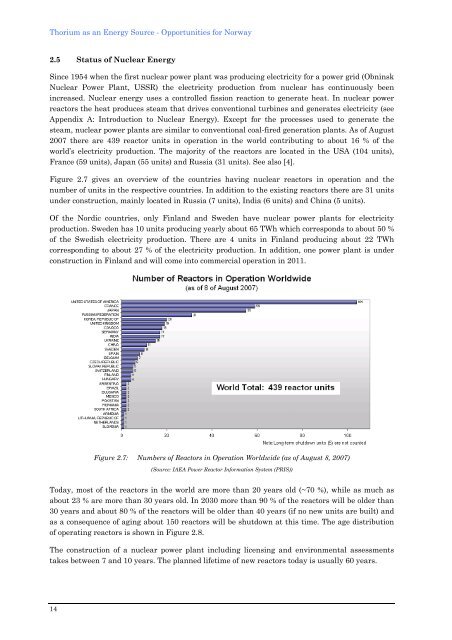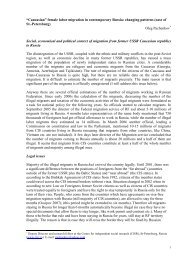THORIUM AS AN ENERGY SOURCE - Opportunities for Norway ...
THORIUM AS AN ENERGY SOURCE - Opportunities for Norway ...
THORIUM AS AN ENERGY SOURCE - Opportunities for Norway ...
Create successful ePaper yourself
Turn your PDF publications into a flip-book with our unique Google optimized e-Paper software.
Thorium as an Energy Source - <strong>Opportunities</strong> <strong>for</strong> <strong>Norway</strong><br />
2.5 Status of Nuclear Energy<br />
Since 1954 when the first nuclear power plant was producing electricity <strong>for</strong> a power grid (Obninsk<br />
Nuclear Power Plant, USSR) the electricity production from nuclear has continuously been<br />
increased. Nuclear energy uses a controlled fission reaction to generate heat. In nuclear power<br />
reactors the heat produces steam that drives conventional turbines and generates electricity (see<br />
Appendix A: Introduction to Nuclear Energy). Except <strong>for</strong> the processes used to generate the<br />
steam, nuclear power plants are similar to conventional coal-fired generation plants. As of August<br />
2007 there are 439 reactor units in operation in the world contributing to about 16 % of the<br />
world’s electricity production. The majority of the reactors are located in the USA (104 units),<br />
France (59 units), Japan (55 units) and Russia (31 units). See also [4].<br />
Figure 2.7 gives an overview of the countries having nuclear reactors in operation and the<br />
number of units in the respective countries. In addition to the existing reactors there are 31 units<br />
under construction, mainly located in Russia (7 units), India (6 units) and China (5 units).<br />
Of the Nordic countries, only Finland and Sweden have nuclear power plants <strong>for</strong> electricity<br />
production. Sweden has 10 units producing yearly about 65 TWh which corresponds to about 50 %<br />
of the Swedish electricity production. There are 4 units in Finland producing about 22 TWh<br />
corresponding to about 27 % of the electricity production. In addition, one power plant is under<br />
construction in Finland and will come into commercial operation in 2011.<br />
Figure 2.7: Numbers of Reactors in Operation Worldwide (as of August 8, 2007)<br />
(Source: IAEA Power Reactor In<strong>for</strong>mation System (PRIS))<br />
Today, most of the reactors in the world are more than 20 years old (~70 %), while as much as<br />
about 23 % are more than 30 years old. In 2030 more than 90 % of the reactors will be older than<br />
30 years and about 80 % of the reactors will be older than 40 years (if no new units are built) and<br />
as a consequence of aging about 150 reactors will be shutdown at this time. The age distribution<br />
of operating reactors is shown in Figure 2.8.<br />
The construction of a nuclear power plant including licensing and environmental assessments<br />
takes between 7 and 10 years. The planned lifetime of new reactors today is usually 60 years.<br />
14

















